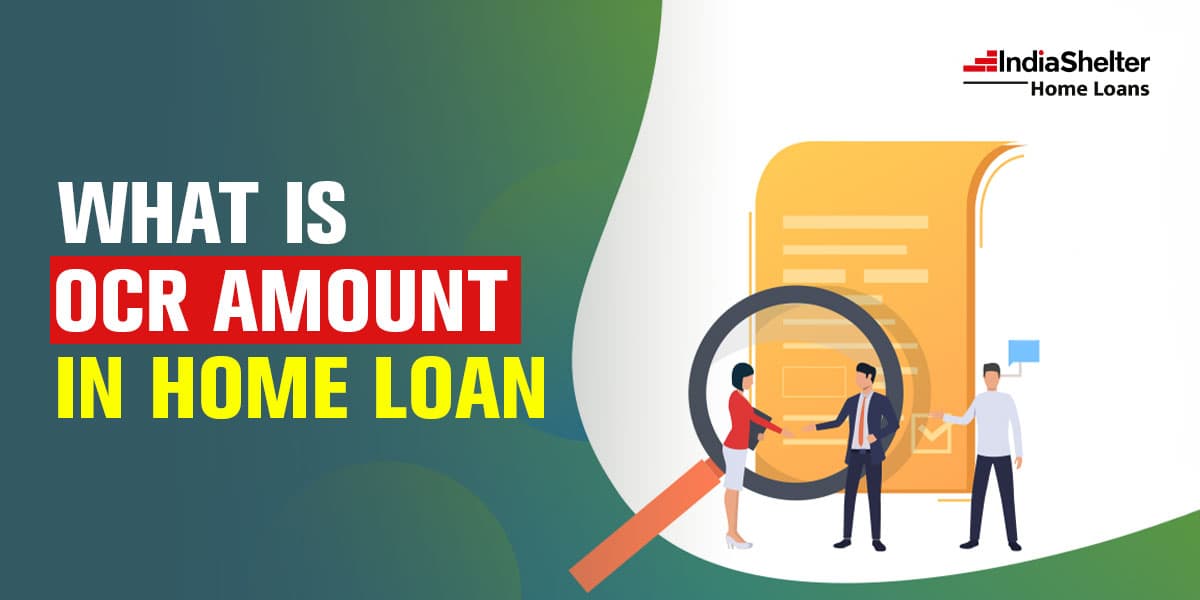What is the OCR amount in a Home Loan?

Published on :2025-01-08
As per the RBI (Reserve Bank of India) mandate, the financial institutions in India that offer home loans cannot sanction 100% of the property's value as a home loan. However, they can approve only a certain percentage of the market value of the property that you want to buy, which could be up to 90%. This means you must not expect to get 100% finance from any lender to complete the purchase transaction.
Let us assume you wish to purchase a property valued at Rs. 1 crore, and the lender agrees to only 80% of its value. This means you can get a maximum loan amount of Rs. 80 Lakh. You must pay the balance amount, i.e., Rs. 20 Lakh, from your pocket. This initial contribution you make towards purchasing the property is called your own contribution (OC). Let us know more about OC and understand what OCR is.
What is your contribution to home loans?
The term OC in home loan refers to the amount of money you pay from your pocket while trying to get a home loan and complete the purchase of the property. Making your contribution is an integral part of the home loan application and approval process and a mandatory requirement.
This percentage of the amount you pay, i.e., your contribution to the property purchase, is also commonly called a down payment. You must make your contribution to the builder or the seller of the property.
What is OCR?
When you make your own contribution to the builder, they will issue a receipt upon receiving the initial payment. This receipt is called OCR. The OCR full form in home loan is basically an own contribution receipt. It is also sometimes referred to as an MMR or margin money receipt.
OCR in home loan is an important document, and it can speed up your loan approval process. When you have the OCR, it will showcase to the lender your financial commitment to purchasing the property for which you are seeking a home loan. Also, when you make your own contribution, it reduces the risk for the lender proportionately.
How much should be the minimum contribution?
As per the RBI rules, the minimum contribution amount you pay to the builder or the property reseller may vary based on the loan amount you want to borrow. The main objective of the OC is to help borrowers lower their loan amount and engage them in the property at a higher level.
As a home loan borrower, you can avail of a loan of up to 90% of the property's value provided the loan you avail of is Rs. 30 Lakh or less. In this case, your minimum own contribution amount would be 10% of the property's value.
If the home loan amount you want to avail is more than Rs. 30 Lakh and up to Rs. 75 Lakh, then the lender will approve only 80% of the property's value as a home loan. So, the minimum contribution you may make would be 20% of the property's value. For a home loan above Rs. 75 Lakh, you must pay a minimum of 25% of the property's value as your contribution amount.
What happens if you fail to meet the OCR requirements?
Raising funds to make your own contribution to a home loan can be quite challenging, especially if you are planning to avail of a high loan amount of more than Rs. 30 Lakh, as the own contribution amount will also increase. In such a scenario, if you don't have the necessary funds, you can either liquidate your savings to collect the funds or wait until you have the desired amount before initiating the home loan application process.
Alternatively, you can raise the funds by applying for a personal loan. However, you must know that if you take out another loan, you will have to meet EMI commitments. This could strain your finances immensely. Also, nursing two loans can, at the same time, lower your credit score.
What happens when you contribute more than the minimum required amount?
If you have made more of your own contribution than the minimum amount required, you can borrow a lower amount. The lower the amount you borrow, the more affordable your EMI will be, and you can easily manage the repayments.
Also, when you borrow less, the overall interest payments you make to the lender are less. If you have surplus funds, you can prepay the amount and close the loan account faster, and you can be debt-free before the end of the actual tenure.
Sometimes, if you make an additional contribution towards the home loan, the lender may return the difference in amount. For example, if you purchase a property valued at Rs. 1 crore, your sanctioned home loan amount is Rs. 75 Lakh. But you have paid Rs. 40 Lakh upfront instead of Rs. 25 Lakh. In this case, the lender may give you an additional Rs. 15 Lakh.
Conclusion
In a nutshell, the OCR is the proof of payment or receipt you receive from the builder for making your own contribution towards the purchase of the property. In other words, it is the difference between the total value of the property you want to buy and the home loan you avail for it.
As a home buyer looking to get a home loan, you must be aware of the OC rules and ensure that you have a financial plan in place to make the payment. Assess your financial condition carefully and make an informed decision.
Related Blogs

2025-12-11
Common Mistakes to Avoid When Applying for a Home Loan in 2026
Planning to take a home loan in 2026? Don’t apply before reading this- learn about the top mistakes many borrowers make and how you can avoid them for smoother approval and lower long-term costs.

2025-07-30
How Green Homes Can Cut Your Electricity Bills by Up to 40%
Discover how simple eco-friendly changes in your home can reduce electricity bills by up to 40% and lower your carbon footprint. Start your green journey today!

2025-07-30
How Much Home Loan Can I Get with a ₹25,000 Monthly Salary?
Wondering how much home loan you can get on a ₹25,000 monthly salary? Find out your eligibility, loan amount, and smart tips to improve approval chances.
Disclaimer: *By contacting IndiaShelter on Toll Free/WhatsApp/Website or any other mode, you authorize our representatives to reach out to you through personal communication via SMS, WhatsApp and phone calls regarding our services. This consent will supersede any registration for any Do Not Call (DNC) / National Do Not Call (NDNC).
© India Shelter Finance Corporation 2024 | All rights reserved
Design with byCyberworx





